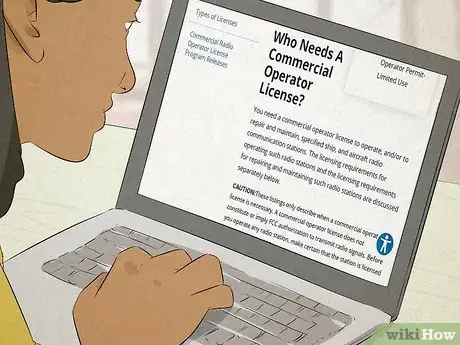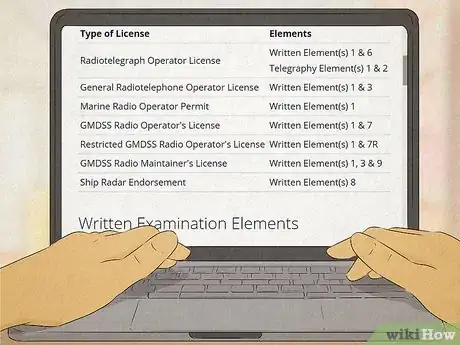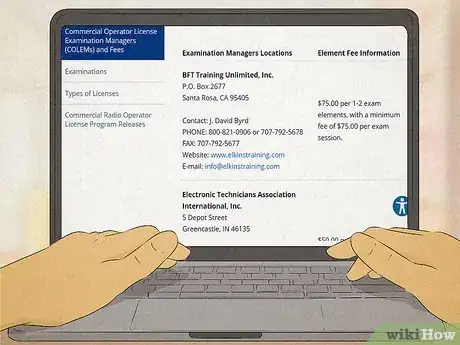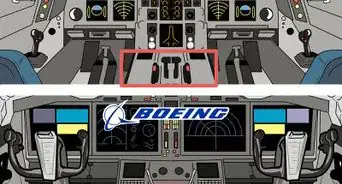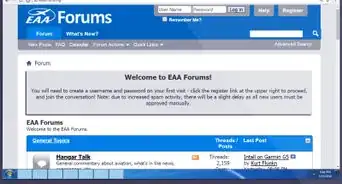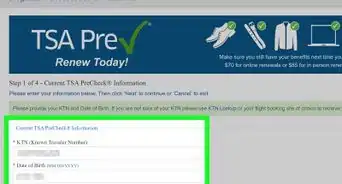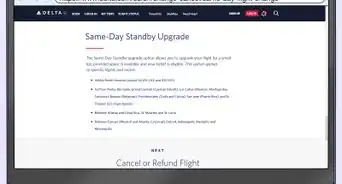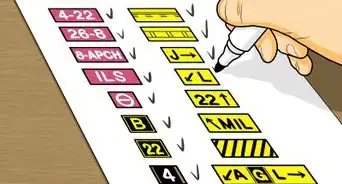This article was co-authored by wikiHow Staff. Our trained team of editors and researchers validate articles for accuracy and comprehensiveness. wikiHow's Content Management Team carefully monitors the work from our editorial staff to ensure that each article is backed by trusted research and meets our high quality standards.
There are 7 references cited in this article, which can be found at the bottom of the page.
This article has been viewed 80,955 times.
Learn more...
The Federal Communications Commission (FCC) administers licenses for ship, aircraft, and international fixed public radio communication stations. The FCC mandates that individuals hold a General Radiotelephone Operators license in order to perform certain specified duties at these stations, such as operating, adjusting, and maintaining the transmitter equipment. [1] Since many jobs in the shipping or aviation fields require the license, it can be useful to obtain. The FCC offers several different types of licenses, so it is necessary to clearly understand the specific exams you need to pass in order to receive your General Radiotelephone Operators license. Additionally, you should consider whether you want to add a "Radar Endorsement" to your license, which is necessary if you plan to work onboard marine vessels.
Steps
Understanding the License
-
1
-
2Understand the general qualifications. In addition to passing the licensing exam, individuals need to be able to receive and send spoken messages in English. Additionally, they must be a legal resident of the United States or legally eligible for employment in the country.[4]
- Once the license is obtained, it is good for life and does not need to be renewed.
Advertisement -
3Learn the exam specifics. To obtain a PG or GROL license, you must first pass a written exam comprising two elements.
- Element 1 of the exam includes questions about basic radio law and operating practice for maritime radio operators. The exam comprises 24 questions, and passing requires answering at least 18 of them correctly.[5]
- Element 3 of the written exam contains 100 questions, of which at least 75 must be answered correctly. This exam focuses on general radiotelephone information, such as the electronic fundamentals of the equipment and techniques for adjusting, repairing and maintaining it. Some of the categories for this exam include operating procedures, radio wave propagation, radio practice, electrical principles, circuit components, practical circuits, signals and emissions, and antennas and feed lines.[6]
- If you have decided to also obtain the radar endorsement for working on marine vessels, you will have to pass Element 8, Ship Radar Techniques.
- Element 8 contains 50 questions, of which 38 must be answered correctly in order to pass. The questions focus on theory and practice of using radar for marine navigation purposes.
Preparing for and Passing the Exam
-
1Download the study materials. The FCC offers everything you need to prepare for the exam. The FCC uses only the questions present in the question pools on its exams.
- On the Examinations page of the FCC Website, scroll down to the bottom of the page and click on "Examination Questions Pool."
- Download the materials for Element 1 and Element 3. (Include Element 8 if you've decided to pursue the radar endorsement as well.)
-
2Study the questions carefully until you've mastered all aspects. If possible, have someone quiz you verbally on the questions.
- It is not recommended that you look for additional outside information for studying purposes. Only questions from the Question Pool will be used on the exam.
-
3Locate an authorized COLEM to administer your test. While the FCC administers and awards the PG licenses, it does not administer the exams required to obtain them. Rather, the FCC authorizes several Commercial Operator License Examination Managers (COLEMs) to conduct the exams nationwide.[7]
- The FCC offers a list of authorized COLEMS on its Website, along with their respective fees. To access this, go to the Examinations page and select "Testing Managers, Locations, Schedules, and Fees."[8]
- Once you have decided which COLEM you will use for your exam, contact them to check when the next scheduled exam is and how to register.
- Many COLEMs offer online testing, in addition to in person exams. This may be beneficial to you if there are no testing facilities in your area.[9]
- In some cases, if you pass the exam, the COLEM will electronically file your application for you. Otherwise, they will give you a Proof of Passing Certificate (PPC) that needs to be included with your license application.
Community Q&A
-
QuestionIf I have a GROL, do I need any other license to operate ham radio?
 DanoyachtcaptTop AnswererYour GROL license is a Commercial Radiotelephone Operators License, authorizing you to operate, maintain, and adjust, commercial radio equipment. The FCC has a separate licensing system for ham radio equipment.
DanoyachtcaptTop AnswererYour GROL license is a Commercial Radiotelephone Operators License, authorizing you to operate, maintain, and adjust, commercial radio equipment. The FCC has a separate licensing system for ham radio equipment. -
QuestionI have a General Radiotelephone Certificate, dated August 9, 1985. It states that it is valid for lifetime, is it still active?
 DanoyachtcaptTop AnswererThe old General Radiotelephone License was a lifetime license, but things have changed recently. There is no longer a General Class License. The General license has been replaced with the Commercial Radiotelephone Operators License. Some people have been able to renew their old license and receive the new license without passing any tests.
DanoyachtcaptTop AnswererThe old General Radiotelephone License was a lifetime license, but things have changed recently. There is no longer a General Class License. The General license has been replaced with the Commercial Radiotelephone Operators License. Some people have been able to renew their old license and receive the new license without passing any tests. -
QuestionI am a TV broadcast engineer, I need to have an FCC General Class License. What steps should I follow to get it?
 DanoyachtcaptTop AnswererThere is no longer a General Class License. The General license has been replaced with the Commercial Radiotelephone Operators License. Just go on line as shown above, and follow the steps for the Commercial Radiotelephone Operators License.
DanoyachtcaptTop AnswererThere is no longer a General Class License. The General license has been replaced with the Commercial Radiotelephone Operators License. Just go on line as shown above, and follow the steps for the Commercial Radiotelephone Operators License.
References
- ↑ https://www.fcc.gov/commercial-radio-operator-license-program
- ↑ http://wireless.fcc.gov/commoperators/index.htm
- ↑ http://www.indeed.com/cmp/South-Florida-Company/jobs/Senior-Captain-544fbdd8d0e963a2?sjdu=QwrRXKrqZ3CNX5W-O9jEvUUdXQhhKNOAMcM5flKILoi5uZRRfnWQgEEqR1evKEbU6aLyM3n5585VfIKm69U-6Q
- ↑
- ↑ https://www.fcc.gov/commercial-radio-operator-license-program
- ↑ https://www.fcc.gov/commercial-radio-operator-license-program
- ↑ http://wireless.fcc.gov/commoperators/index.htm?job=cole
- ↑ http://wireless.fcc.gov/commoperators/index.htm?job=cole
- ↑ http://www.eta-i.org/fcc_licenses.html
